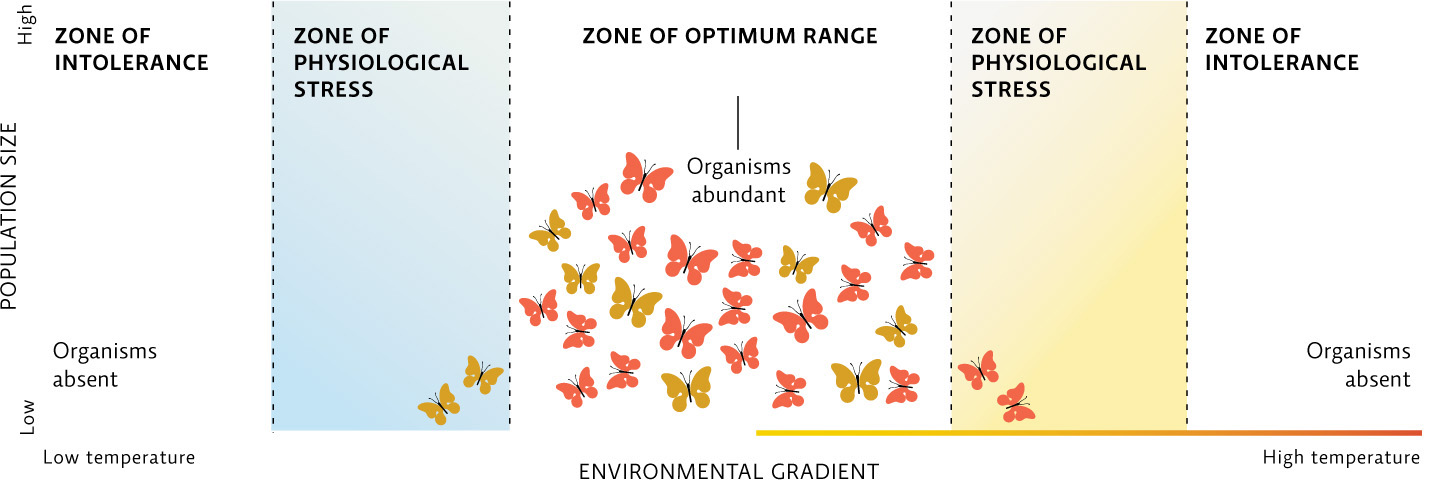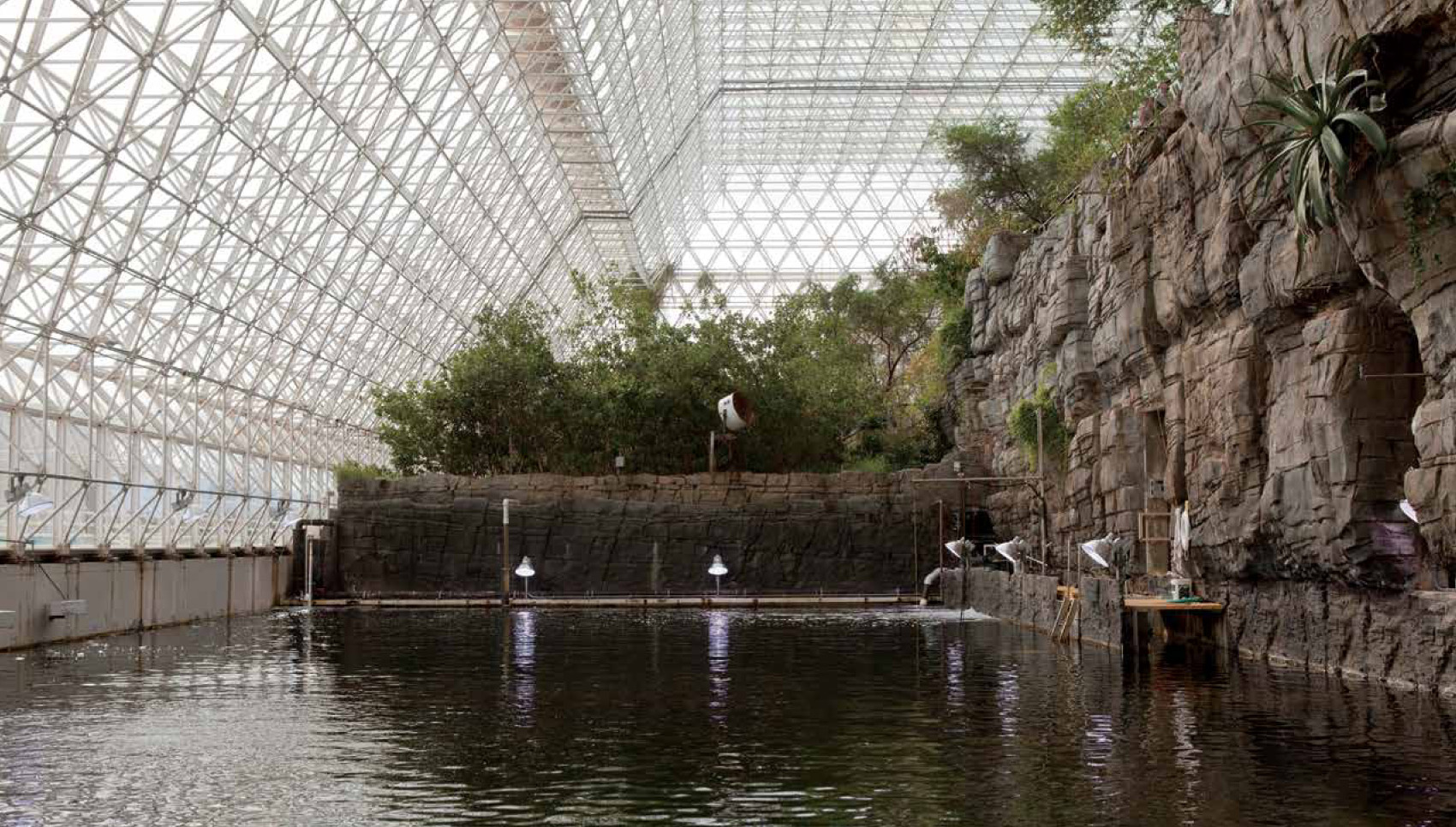6.3 Living things survive within a specific range of environmental conditions.
Each biome required a mind-boggling array of considerations—not only how diverse plant and animal species would interact within and across biomes, but also the nutrient requirements of each organism they planned to include. Termites, for example, would need enough dead wood at the beginning of closure to sustain them until some of the larger plants began dying off. Termites live in the soil, stirring it and allowing air to penetrate soil particles. If the termites ran out of dead wood and starved to death, organisms living in the soil would not get enough oxygen and the entire desert would be jeopardized. Hummingbirds, on the other hand, would need nectar-filled flowers. “Try figuring out how many flowers a day a hummingbird needs,” says Tony Burgess, a University of Arizona ecologist who helped design the biomes in Biosphere 2 and remained involved until 2004. “From there you need to know what the blooming season is, and then what the nectar load per flower is. And then you have to translate all of that into units of hummingbird support. Now imagine doing that sort of thing about 3000 times.”
Biome-level planning was equally complicated. A rainforest would need consistently warm temperatures, but most desert biomes fluctuate wildly between day and night. In the summer, the grassland biome might literally starve the rainforest by gobbling up all the CO2 needed for photosynthesis.
In this context, dead wood, flowers, and CO2 are all examples of limiting factors—resources so critical that their availability controls the distribution of species and thus of biomes. The principle of limiting factors states that the critical resource in least supply is what determines the survival, growth, and reproduction of a given species in a given biome. Living things can only survive and reproduce within a certain range (between the upper and lower limits that they can tolerate) for a given critical resource or environmental condition, referred to as their range of tolerance. [infographic 6.6]

102

Ecologists routinely monitor a variety of limiting factors as a way of assessing ecosystem health, but anticipating what each individual organism would need to survive before the fact proved daunting.
An all-star team of scientists—oceanographers, forest ecologists, and plant physiologists—spent 2 years sorting through these challenges. Drawing on their combined expertise, they set about choosing the combination of soils, plants, and animals that seemed most capable of working together to recreate the delicate balances that had made Biosphere 1 such a spectacular success. A summer-dormant desert, like the ones found in Baja California, was chosen because it would reduce the desert’s CO2 demands when the savannah’s productivity was at its highest. The ocean was situated between the desert and rainforest so that it could serve as a temperature buffer between the two. And each biome was created from a carefully selected array of species: the marsh biome was composed of intact chunks of swampland harvested from the Florida Everglades, and the savannah was composed of grasses from Australia, South America, and Africa. Well water mixed with aquarium salt filled the ocean, to which were added coral reef sections culled from the Caribbean.
But it wasn’t long before the rigour and pragmatism of good science began to clash with the idealism of Biosphere 2 financiers. And when that happened, critics say, science lost out.
Some scientists worried that the ocean wouldn’t get enough sunlight to support plant and animal life. Others opposed the use of soil high in organic matter; soil microbes decompose the soil‘s organic carbon and release it into the air as CO2. Although this organic soil might eliminate the need for chemical fertilizers, there were concerns that it would provide too much fuel for the soil microbes, and would thus send atmospheric CO2 concentrations through the roof. Despite these concerns, scientific advisors to the project were overruled.
The first few months of Mission 1 went smoothly enough, but eventually, plants and animals started dying. Humans grew hungry and mysteriously sleepy. And before long, they turned on each other.
Like Earth, Biosphere 2 was designed as a materially closed and energetically open system: plants would conduct photosynthesis with sunlight that streamed through the glass, but no biomass would enter or leave. Temperature, wind, rain, and ocean waves would be controlled mechanically. “But the facility would have to be self-sustaining,” says Burgess. “Everything would die, unless the biota met its most fundamental purpose—using energy flow for biomass production.” Humans would have to survive exclusively on what they could grow or catch under the dome. The system as a whole would have to continuously recycle every last bit of nutrient that was in the soil on day one.
103
At first, the carefully constructed agricultural biome seemed well suited to the challenge. Carrots, broccoli, peanuts, kale, lettuce, and sweet potatoes were grown on broad quarter-hectare terraces that sat adjacent to the sprawling six-storey human habitat. A bevy of domestic animals also provided sustenance—goats for milk, chickens for eggs, and pigs for pork. Indeed, eating only what they could grow made the biospherians healthier. Everyone lost weight. Bad cholesterol and blood pressure went down; so did white blood cell counts. And slowly, the biospherians say, their relationship to food changed. “Inside, I knew exactly where my food came from, and I totally understood my place in the biosphere and how it impacted the food I ate,” says Jayne Poynter, the biospherian responsible for tending the farm. “When I breathed out, my CO2 fed the sweet potatoes that I was growing. When I first got out, I lost sense of that. I would stand for hours in the aisles of shops, reading all the names on all the food things and think ‘where does this stuff come from?’ People must have thought I was nuts.”
But the glazed glass of the dome admitted less sunlight than had been anticipated. Less sunlight meant less biomass production. And that meant less food. Mites and disease also cut crop production. Biosphere 2’s size precluded the use of pesticides and herbicides: in that small an atmosphere, the toxins would build up rapidly and could have had a deleterious impact on air quality and human health.
Now, a few months in, food was starting to run out. And that wasn’t the only problem.
The humans were so tired they couldn’t work. Nobody knew why, but scientists on the outside suspected it had something to do with nutrient cycles.